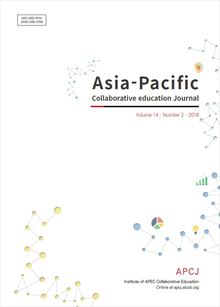간행물
Asia-Pacific Collaborative education Journal

- 발행기관 APEC국제교육협력원
- 자료유형 학술지
- 간기 반년간
- ISSN 2092-674X (Print)2092-6758 (Online)
- 수록기간 2004 ~ 2021
- 주제분류 사회과학 > 교육학 사회과학 분류의 다른 간행물
- 십진분류KDC 371DDC 379
권호리스트/논문검색
Volume 4 Number 1 (2008년 6월) 6건
1.
2008.06
구독 인증기관 무료, 개인회원 유료
This paper reports on an experiment spanning 3 years that was conducted to gain an insight into the state of distance education in the doctoral program of a school of education. There is also a description of the structure of the information and communication network used in the courses. Distance education in graduate schools can be expected to be effective for the research guidance of both on-campus and off-campus students. The network requires confidentially, moving images that convey the expressions of others, clear audio, sharing of images, and the ability for participants to control communications, among other things.
4,600원
2.
2008.06
구독 인증기관 무료, 개인회원 유료
In this study, Modular Object Oriented Dynamic Learning Environment (MOODLE), an open-source Learning Management System (LMS) developed by Curtain University of Technology in Australia, was customized for essay writing classes in Korean. The subjects were 18 elementary school students who participated in an essay writing program over 6 weeks. Using a case study approach, the study reports some important lessons learned from the use of MOODLE to design blended, collaborative learning environments for elementary essay writing. Some important contextual factors and content-specific constraints that affected the student learning process are discussed.
4,000원
3.
2008.06
구독 인증기관 무료, 개인회원 유료
The purpose of this article is to examine the possibilities of Human Performance Technology (HPT) under the background of global economy. First, two kinds of culture, national culture and organizational culture are introduced and compared. Next, the impact of cultures on human learning and working performance is examined in the aspects of learning and training, management, and global cooperation. And then the article proposes different strategies for managing the factor of culture to achieve desired performance, including diffusion and adaption. In addition, it is considered that how the proposed strategies can be utilized for public education systems. Finally, further research agenda is addressed Living in a culture is like swimming in the water is for a fish: one does not recognize one’s basic cultural values and beliefs as being there. They are the water one swims in. Everything one does takes this water into account unconsciously (Addison & Wittkuhn, 2001, p. 16). Pushing harder and harder on familiar solutions, while fundamental problems persist or worsen, is a reliable indicator of nonsystemic thinking- what we often call the “what we need here is a bigger hammer” syndrome (Senge, 1994, p. 61).
4,600원
4.
2008.06
구독 인증기관 무료, 개인회원 유료
Human performance technology (HPT) has over 30 years of practice in real working settings and research in academia. The application of HPT principles, strategies, and models is aimed at solving performance problems and improving performance at all levels. Performance is the key word, and to improve performance is the value that HPT brings to individuals, organizations, and society. This article addresses questions centering on performance: 1) Where does the word performance come from? 2) What does performance really mean in HPT? And 3) what is HPT studying about performance? The concept of performance comes from Gilbert’s notion of worthy performance which distinguishes behavior from accomplishment. Specifically, accomplishment is the positive and valued outcomes of behavior and the transaction from behavior to accomplishment is the performance that HPT focuses on. Performance is not a simple term, but a complex system in which factors are interacting with each other to affect performance. As a science of performance, HPT applies systematic approaches to investigate the relationship between and interaction among the affecting factors in a performance system.
4,000원
5.
2008.06
구독 인증기관 무료, 개인회원 유료
The purpose of this study was to examine specific characteristics in IT companies’ HR practices in South Korea. Interviews with 12 HR executives and a survey of 51 IT companies showed that there were specific HR practices unique to the IT industry: a strong emphasis on talent; the importance of performance-based HR; the need for alignment of corporations, universities, and the government for an R&D workforce; and a government-led HR strategy for the IT industry in order to have a national power base.
4,900원
6.
2008.06
구독 인증기관 무료, 개인회원 유료
4,600원

